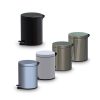Recycling is not a new concept, with most people recycling papers in school or at work. Most large cities also provide central recycling bins with regular pick-ups, like trash. Unfortunately, despite these efforts, the average national recycling rate still stands at 35%. This means that even though the population has some basics of recycling, they need more tips and knowledge to improve this percentage. That said, the following tips can help improve your Home Recycling Program efforts.
1. Start with the Basics: Reduce, Reuse, Recycle- Home Recycling Program
The aphorism “reduce, reuse, and recycle” is probably the most popular recycling phrase known. However, most people have heard and practiced recycling more than reducing and reusing materials. Nonetheless, the first step to improving your home recycling program is reducing how much you consume and shifting your consumption to properly designed products.
The next step is to find constructive use of waste materials. If something is broken, try fixing it before replacing it. Tossing items in your blue bins should always be the last option. Balancing these three important principles can significantly reduce the amount of landfill waste.
2. Know What Can Be Recycled
You can easily overlook or be confused by items that can be recycled and those that cannot. Therefore, check up on your local recycling rules to know what can be recycled and what cannot. While every city may have specific rules, below are some items that can be recycled.
- Paper and cardboard – all types of papers, including flyers, junk mail, books, and colored paper, can be recycled. Cardboards can be recycled provided they are not saturated with grease or food, like pizza boxes. Always remove liners from cereal and food boxes before recycling.
- Plastic – most plastics that can be recycled have numbers on the bottom. Plastics with numbers from one to seven can be recycled. Interestingly, disposable utensils are not accepted due to low quality plastic blend used during manufacture.
- Aluminum – all types of aluminum cans can be recycled. Simply rinse the liquids, especially in juice and soda cans, to avoid attracting bugs.
- Glass – nearly all glass containers are recyclable. Like cans, rinse before placing them in recycling bins. Also, be careful to avoid shuttering them, as broken glasses cannot be recycled.
3. Have a Recycling Bin in Every Room
Be it a coincidence or a norm; most families interestingly have their collection bins in the kitchen. This means that other rooms have become neglected, allowing even materials that can be recycled to be dumped in disposable trash cans. That said, place bins in every room to improve collection. For instance, place bins in your bathroom for collecting finished toilet paper rolls, pill bottles, packaging, and empty containers that can be recycled.
If you have a home office, workspace, or craft room, place bins to collect pamphlets, flyers, printer paper, and empty bottles. Don’t forget your garage, where there are several recyclable products, such as project waste, jars, bottles, and other items from your car.
4. Recycle Tech Products and Old Appliances
As more people embrace the use of technology products, landfills are also brimming with obsolete computer systems, phones, printers, televisions, and more. Instead of disposing of your damaged tech products, contact a nearby electronic store to inquire if they have recycling programs. Most electronic stores often take back some electrical items or can connect you with companies that can assist. Manufacturers of these items also accept unwanted items, which they can refurbish or use as spare parts.
Note that it is dangerous to discard old appliances in the trash, especially freezers and fridges manufactured before 1995. Most of these appliances have type CFC-11 insulation, which can harm the environment. To dispose of these appliances better, check out EPA’s Responsible Appliance Disposal Program.
5. Recycle Food and Water
Recycling food materials is commonly known as composting. The organic matter remains a major source of methane emission, which landfills are unfortunately bursting with. The United Nations Environment Program estimates that, on average, 20lbs of food is wasted monthly per person. This makes organic land waste the 2nd largest component in landfills.
Fortunately, you can compost organic waste at home using a DIY bin or buy an indoor or outdoor bin. If you have large amounts of food waste, check if your city or local authority has a recycling pick-up service specifically designed for organic wastes. Most commercial composting facilities only accept plant-based materials, meat, and dairy items.
Food aside, you can also recycle water before allowing it to swirl down. This could be as simple as directing used water to flower beds or modifying your plumbing so that you can use greywater.
Conclusion
Recycling is a great way of conserving raw materials and saving energy. For instance, the Environmental Protection Agency estimates that recycling one ton of paper saves 17 trees and up to 7000 gallons of water. Work with a recycling pick-up service provider, to actualize your efforts. Check out Cleanawater for more information on wastewater.
I believe in the power of words and I think God has blessed me with the same. I have a strong experience in the area of writing and love to share my work with the readers. Happy reading!!







